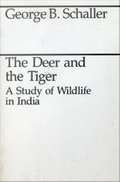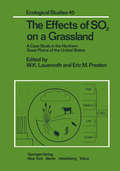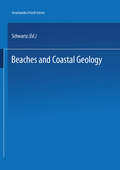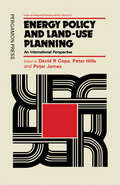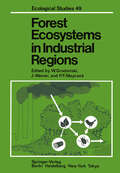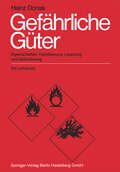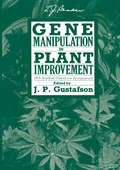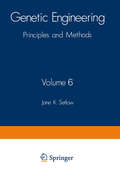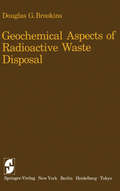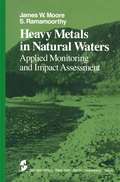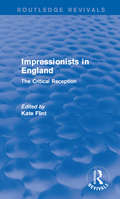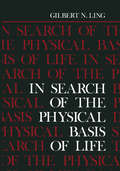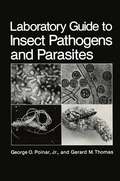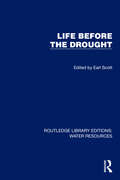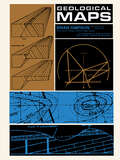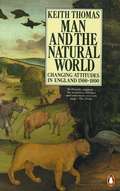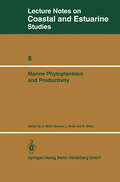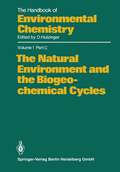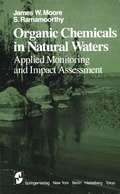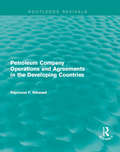- Table View
- List View
The Deer and the Tiger: Study of Wild Life in India
by George B. SchallerThe Deer and the Tiger is Schaller's detailed account of the ecology and behavior of Bengal tigers and four species of the hoofed mammals on which they prey, based on his observations in India's Kanha National Park. "This book is a treasure house of biological information and it is also a delight to read. . . . Excellent phoographs accompany the text."—Robert K. Enders, American Scientist "The one book that has been my greatest source of inspiration is The Deer and the Tiger by George Schaller, based on the first ever scientific field study of the tiger. . . . This book is written by a scientist, but speaks from the heart. . . . It reveals startling information on feeding habitats, territorial behaviour, and the nuances that make up the language of the forest; you become totally immersed in the world of the tiger. . . . For all of us who work in tiger conservation, this book is the bible."—Valmik Thapar, BBC Wildlife
The Effects of SO2 on a Grassland: A Case Study in the Northern Great Plains of the United States (Ecological Studies #45)
by William Lauenroth E. M. Preston William 1727-1791 WilliamsWhen Springer-Verlag undertook publication of this volume, two opportunities arose. The first was to bring together the significant findings ofthe interacting parts of a large field experiment on a whole ecosystem. Scientific specialists and the public are rightly concerned with large-scale impacts of human activity on landscapes and with the challenge of predicting subtle, long-range repercussions of air pollution. A fundamental issue is whether ecological systems like grasslands, which have evolved for several million years under stressful conditions such as variable climate and overgrazing, are more robust than other systems in tolerating new atmospheric impacts of pollution and toxicity. At what level, and when, will an extra geochemical input, like sulfur (Chapter 4), an essential nutrient for proteins and life processes, become an overload on these systems? Some grasses and grassland ecosystems seem fairly adaptable to burdens in addition to those of weather change and tissue removal. How can experts learn to project the future of the heartland of America and other grasslands of the world on the basis of only a few years of observation and control? The second opportunity addresses a broader aspect of the project that is of interest to many readers who are not concerned with details of physiology or food chains, or the overall productivity and variations of a single plant-animal-soil community.
The Encyclopedia Of Beaches And Coastal Environments: (pdf) (Encyclopedia Of Earth Sciences Ser.)
by M. SchwartzEnergy Policy and Land-Use Planning: An International Perspective (Urban and Regional Planning Series #Volume 32)
by D. R. Cope P. Hills P. JamesThis book fills a gap in the available literature on energy policy by dealing with the relationship between energy and land-use planning. It considers, in a systematic way, energy developments in national, regional and local planning policy contexts, concentrating particularly on energy supply issues in Europe.
Forest Ecosystems in Industrial Regions: Studies on the Cycling of Energy Nutrients and Pollutants in the Niepo?omice Forest Southern Poland (Ecological Studies #49)
by W. Grodzinski J Weiner P. MaycockA number of well-known forests have been the object of studies by ecological teams. Every ecologist is familiar with the names of forests such as Whytham Woods in England (Elton 1966), Solling in West Germany (Ellenberg 1971), Hubbard Brook in New Hampshire, U. S. A. (Likens et al. 1977, Bormann and Likens 1979), and ladra6s in Central Sweden (Persson 1980). The number of such team studies grew rapidly during the period of the International Biological Programme (Reichle 1981). Each of these forests represented aspects oflocal and general interest. The Niepolomice Forest in Southern Poland (Fig. 1) does not possess any spectacular features and it may be regarded as a typical forest of the lowlands of continental Europe. Situated in the Vistula River Valley, 20 km east of Cracow (50°07' N, 20°23' E) it consists of two major sections: an extensive pine forest of the Pino-Quercetum type, and a smaller, deciduous, oak-hornbeam- Fig. 1. The location of the Niepolomice Forest in Southern Poland VI Preface Tilio Carpinetum forest. This huge forested area (11,000 ha) owes its survival in one of the most densely populated parts of Europe to a long period of protection as a royal hunting ground. The period of royal protection ended abruptly at the turn of 20th century under the devastating blows of two world wars followed by perhaps an even greater danger, the effects of modern developments in heavy industry.
Gene Manipulation in Plant Improvement: 16th Stadler Genetics Symposium (Stadler Genetics Symposia Series)
by J. Perry GustafsonThe results obtained to date involving the use of in ~ methods to facilitate wide hybridization in plants are voluminous and impressive. The techniques of embryo culture, ovule culture, and in~ pollination and fertilization represent an extension of the normal sexual hybridization process. Successes recorded in obtaining hybrids stem largely from circumventing prezygotic or postzygotic hybridization barriers. Numerous recent successful hybridizations were possible because of the development of improved tissue and cell culture systems for crop plants and attention given to genotypes used in hybridization attempts. Interspecific and intergeneric hybridization utilizing the process of protoplast fusion will bypass the limits set by all sexual me'thods. In addition to combining complete genomes from two different species through protoplast fusion, this system affords unique opportunities for creating novel cytoplasmic combinations, transfer of individual chromosomes, transfer of cytoplasmic organelles, manipulation of male sterility, and for single gene transfer. Some caution must be noted with regard to the extent of hybridization possible between distantly related species. Although practically no limit exists to the physical fusion of protoplasts from widely divergent species, the restrictions imposed by somatic incompatibility have not been adequately addressed. Regeneration of plants from the protoplast or single heterokaryon level is still a major hurdle for many important crop species before somatic cell fusion can be exploited to produce interspecific and intergeneric hybrids. Identification and selection of hybrids is also a limitation to the efficient application of cell fusion methods.
Genetic Control of Environmental Pollutants (Basic Life Sciences #28)
by Gilbert S. Omenn Alexander Hollaender Claire M. WilsonGilbert S. Omenn Dean, Public Health and Community Medicine University of Washington Seattle, Washington 98195 On behalf of the University of Washington, the City of Seattle, the sponsors and donors, and my co-organizers, I am delighted to welcome all of you to this Conference on Genetic Control of Environ mental Pollutants. My only regret is that Dr. Alexander Hollaender, who has inspired so many of us as young scientists and stimulated so many trail-blazing conferences in environmental sciences and in gen etic engineering, is ill and was unable to make the trip to Seattle. He sends his warm good wishes for an outstanding meeting and a fine volume. The purpose of this Conference is to identify and assess strat egies for more effectively and safely managing wastes and toxic sub stances in the environment, in part through use of genetically engi neered microorganisms. There is a sense of desperation in our soci ety that modern technologies have introduced a bewildering array of potential hazards to human health and to our environment. There is an accompanying sense of frustration that our prodigious basic re search capabilities and our technological ingenuity have not yielded practical ways to control many pollutants and waste streams, or- better still--to convert them to useful products.
Genetic Engineering: Principles and Methods (Genetic Engineering: Principles and Methods #6)
by Jane SetlowGeochemical Aspects of Radioactive Waste Disposal
by D. G. BrookinsThere is an extremely voluminous literature on radioactive waste and its disposal, much in the form of government-sponsored research reports. To wade through this mountain of literature is indeed a tedious task, and it is safe to speculate that very few, if any, individuals have the time to examine each report that has been issued during the preceding ten years. This book attempts to summarize much of this literature. Further, many workers in the geosciences have not received training in the nuclear sciences, and many nuclear scientists could be better versed in geology. In this book an attempt is made to cover some background material on radioactive wastes and geotoxicity that may not be an integral part of a geologist's training, and background material on geology and geochemistry for the nuclear scientist. The geochemical material is designed for both the geoscientist and the nuclear scientist. There is no specific level for this book. Certainly, it should be useful to advanced undergraduates and graduates studying geology and nuclear science. It does not pretend to cover a tremendous amount of detail in all subjects, yet the references cited provide the necessary source materials for follow-up study. It is my intention that the reader of this book will have a better, broader understanding of the geochemical aspects of radioactive waste disposal than is otherwise available in anyone source.
Heavy Metals in Natural Waters: Applied Monitoring and Impact Assessment (Springer Series on Environmental Management)
by J.W. Moore S. RamamoorthyThis series is dedicated to serving the growing community of scholars and practitioners concerned with the principles and applications of environ mental management. Each volume is a thorough treatment of a specific topic of importance for proper management practices. A fundamental objective of these books is to help the reader discern and implement man's stewardship of our environment and the world's renewable re sources. For we must strive to understand the relationship between man and nature, act to bring harmony to it, and nurture an environment that is both stable and productive. These objectives have often eluded us because the pursuit of other individual and societal goals has diverted us from a course of living in balance with the environment. At times, therefore, the environmental manager may have to exert restrictive control, which is usually best applied to man, not nature. Attempts to alter or harness nature have often failed or backfired, as exemplified by the results of imprudent use of herbicides, fertilizers, water, and other agents. Each book in this series will shed light on the fundamental and applied aspects of environmental management. It is hoped that each will help solve a practical and serious environmental problem.
Impressionists in England (Routledge Revivals): The Critical Reception
by Kate FlintFirst published in 1984. The late nineteenth and early twentieth centuries represent not only era of rapidly changing artistic methods but a crucial evolution in art criticism. This book gathers together a wide-range of the criticism that greeted the work of the Impressionists artists in the English Press. The selected examples of praise and antagonism reflect the sentiments expressed in the comments of prominent newspaper and periodical critics. The selection shows the importance of Impressionist art to English art criticism and wide comprehension of the formal qualities in painting. It also demonstrates how forward-looking critics created new criteria for the discussion of modern painting.
Impressionists in England (Routledge Revivals): The Critical Reception
by Kate FlintFirst published in 1984. The late nineteenth and early twentieth centuries represent not only era of rapidly changing artistic methods but a crucial evolution in art criticism. This book gathers together a wide-range of the criticism that greeted the work of the Impressionists artists in the English Press. The selected examples of praise and antagonism reflect the sentiments expressed in the comments of prominent newspaper and periodical critics. The selection shows the importance of Impressionist art to English art criticism and wide comprehension of the formal qualities in painting. It also demonstrates how forward-looking critics created new criteria for the discussion of modern painting.
In Search of the Physical Basis of Life
by Gilbert LingIt is highly probable that the ability to distinguish between living and nonliving objects was already well developed in early prehuman animals. Cognizance of the difference between these two classes of objects, long a part of human knowledge, led naturally to the division of science into two categories: physics and chemistry on the one hand and biology on the other. So deep was this belief in the separateness of physics and biology that, as late as the early nineteenth century, many biologists still believed in vitalism, according to which living phenomena fall outside the confines of the laws of physics. It was not until the middle of the nineteenth century that Carl Ludwig, Hermann von Helmholz, Emil DuBois-Reymond, and Ernst von Briicke inaugurated a physicochem ical approach to physiology in which it was recognized clearly that one set of laws must govern the properties and behavior of all matter, living and nonliving . . The task of a biologist is like trying to solve a gigantic multidimensional crossword fill in the right physical concepts at the right places. The biologist depends on puzzle: to the maturation of the science of physics much as the crossword solver depends on a large and correct vocabulary. The solver of crossword puzzles needs not just a good vocabulary but a special vocabulary. Words like inee and oke are vitally useful to him but are not part of the vocabulary of an English professor.
Laboratory Guide to Insect Pathogens and Parasites
by G.O. Poinar Jr. G.M. ThomasAfter the publication of the Diagnostic Manual for the Identification of Insect Pathogens, the authors received many queries asking why they had not included the larger metazoan parasites as well as the microbial forms. An examination of the literature indicated that pictorial guides to the identification of nematodes and the immature stages of insect parasites were unavailable. Consequently we decided to rewrite the sections cover ing insect pathogens and combine these with new sections on ento mogenous nematodes and the immature stages of insect parasites. The result is the present laboratory guide, which is unique in covering all types of biotic agents which are found inside insects and cause them injury or disease. Included as parasites are insects and nematodes. Among the pathogens included are viruses, rickettsias, bacteria, fungi, and protozoans. Emphasis is placed on identification with an attempt to use the most easily recognizable characters. Use of a certain number of technical terms is unavoidable, and explanations of these can be found in most biological dictionaries or the glossary of invertebrate pathology prepared by Steinhaus and Martignoni (1970).
Life Before the Drought (Routledge Library Editions: Water Resources)
by Earl ScottLittle attention had been paid to the realities of life in the Savanna-Sahel of West Africa before the drought of 1968-74, but this book, originally published in 1984 provides a set of authoritative accounts of the way in which the inhabitants cope with what outsiders perceive as a harsh environment. The peoples of the Savanna-Sahel are shown to be developers of strategies and technologies to manage their resources. Their understanding of the environment enables them to contribute substantially to any plans for economic and ecological recovery in the region. Their cooperative modes of life lead to greater social complexity and capacity for survival. Geographers, anthropologists and social historians should find the interdisciplinary human ecological approach of the book appealing. Development economists and rural planners will find the chapters on land-use patterns, and resource use particularly valuable.
Life Before the Drought (Routledge Library Editions: Water Resources)
Little attention had been paid to the realities of life in the Savanna-Sahel of West Africa before the drought of 1968-74, but this book, originally published in 1984 provides a set of authoritative accounts of the way in which the inhabitants cope with what outsiders perceive as a harsh environment. The peoples of the Savanna-Sahel are shown to be developers of strategies and technologies to manage their resources. Their understanding of the environment enables them to contribute substantially to any plans for economic and ecological recovery in the region. Their cooperative modes of life lead to greater social complexity and capacity for survival. Geographers, anthropologists and social historians should find the interdisciplinary human ecological approach of the book appealing. Development economists and rural planners will find the chapters on land-use patterns, and resource use particularly valuable.
Living Cities: A Case for Urbanism and Guidelines for Re-urbanization
by Jan TangheThis book aims to demonstrate the new awareness concerning the urban environment in Europe. The authors believe that the unlimited outward expansion of our cities must be halted and that we should strive for "inner growth" within urban centres, and for a more human approach to city development. Contact between city dwellers should be encouraged to reduce the isolation of those living in sprawling communities and to remedy the evils resulting from the dispersion of urban functions. To achieve this the book puts forward a number of planning and design criteria which would solve more satisfactorily the problems of housing and living conditions in cities.
Man and the Natural World: Changing Attitudes in England 1500-1800 (Penguin History Ser.)
by Keith Thomas'Man and the Natural World, an encyclopaedic study of man's relationship to animals and plants, is completely engrossing ... It explains everything - why we eat what we do, why we plant this and not that, why we keep pets, why we like some animals and not others, why we kill the things we kill and love the things we love ... It is often a funny book and one to read again and again' Paul Theroux, Sunday Times 'The English historian Keith Thomas has revealed modes of thought and ways of life deeply strange to us' Hilary Mantel, New York Review of Books'A treasury of unusual historical anecdote ... a delight to read and a pleasure to own' Auberon Waugh, Sunday Telegraph'A dense and rich work ... the return to the grass roots of our own environmental convictions is made by the most enchantingly minor paths' Ronald Blythe, Guardian
Marine Phytoplankton and Productivity: Proceedings of the invited lectures to a symposium organized within the 5th conference of the European Society for Comparative Physiology and Biochemistry — Taormina, Sicily, Italy, September 5–8, 1983 (Coastal and Estuarine Studies #8)
by O. Holm-Hansen L. Bolis R. GillesWhen I was asked to organize this symposium on marine producti vity, it made me reflect on what aspects of this subject would be stimulating to a heterogeneous group of laboratory-oriented physiolo gists and biochemists. In recent years there have been several books which discusses the methodology commonly used in primary production studies and described the magnitude of photosynthetic CO reduction 2 in various areas of the world's oceans. I therefore decided to dis pense with these conventional aspects of primary production and invite researchers to speak on a variety of problems relating the abundance and activity of phytoplankton to environmental conditions. The lectures I invited were thus quite diverse in character, but all were related either to factors affecting the rate of photosynthesis or to the fate of reduced carbon as it passes through the microbial food web. In addition to these talks the participants benefited from a number of shorter presentations and poster sessions which dealt with production and cycling of organic carbon in the marine environment. February 1984 Osmund HOLM-HANSEN CONTENTS 1. Factors Governing Pelagic Production in Polar Oceans E. SAKSHAUG and O. HOLM-HANSEN •. ••. ••••. . . . . . •. •••. . ••••. •. •••• 1 2. Productivity of Antarctic Waters. A Reappraisal S. Z. EL-SAYED •. . . ••••••••. . •••. •. •••••••••. •••. •. •. . . . •. . . . •. 19 3. A Thermodynamic Description of Phytoplancton Growth D. A. KIEFER. . . . . . . . . . . . . . . . . . . . . . . . . . . . . . . . . . . . . . . . . . . . . . . . . . 35 4. Mechanisms of Organic Matter Utilization by Marine Bacterio plankton 45 F. AZAM and J. W.
The Natural Environment and the Biogeochemical Cycles (The Handbook of Environmental Chemistry #1 / 1C)
by G. G. ChoudhryEnvironmental Chemistry is a relatively young science. Interest in this subject, however, is growing very rapidly and, although no agreement has been reached as yet ab out the exact content and limits of this interdisciplinary discipline, there appears to be increasing interest in seeing environmental topics which are based on chemistry embodied in this subject. One of the first objectives of Environmental Chemistry must be the study of the environment and of natural chemical processes which occur in the environment. A major purpose of this series on Environmental Chemistry, therefore, is to present a reasonably uniform view of various aspects of the chemistry of the environment and chemical reactions occurring in the environment. The industrial activities of man have given a new dimension to Environmental Chemistry. We have now synthesized and described over five million chemical compounds and chemical industry produces about hundred and fifty million tons of synthetic chemicals annually. We ship billions of tons of oil per year and through mining operations and other geophysical modifications, large quantities of inorganic and organic materials are released from their natural deposits. Cities and metropolitan areas of up to 15 million inhabitants produce large quantities of waste in relatively small and confined areas. Much of the chemical products and was te products of modern society are released into the environment either during production, storage, transport, use or ultimate disposal. These released materials participate in natural cyc1es and reactions and frequently lead to interference and disturbance of natural systems.
Organic Chemicals in Natural Waters: Applied Monitoring and Impact Assessment (Springer Series on Environmental Management)
by J.W. Moore S. RamamoorthyThis series is dedicated to serving the growing community of scholars and practitioners concerned with the principles and applications of environ mental management. Each volume is a thorough treatment of a specific topic of importance for proper management practices. A fundamental objective of these books is to help the reader discern and implement man's stewardship of our environment and the world's renewable re sources. For we must strive to understand the relationship between man and nature, act to bring harmony to it, and nurture an environment that is both stable and productive. These objectives have often eluded us because the pursuit of other individual and societal goals has diverted us from a course of living in balance with the environment. At times, therefore, the environmental manager may have to exert restrictive control, which is usually best applied to man, not nature. Attempts to alter or harness nature have often failed or backfired, as exemplified by the results of imprudent use of herbicides, fertilizers, water, and other agents. Each book in this series will shed light on the fundamental and applied aspects of environmental management. It is hoped that each will help solve a practical and serious environmental problem.
Oxygen Transport to Tissue-V (Advances in Experimental Medicine and Biology #169)
by D. W. LubbersOn the understanding that few people ever read the preface to any book and also on the understanding that even those few people who do read the preface realize that virtually nothing of any substance is ever said, I shall write at such length as will be proportional to my expected readership. The meetings of the International Society on Oxygen Transport to Tissue provide a forum for discussion amongst scientists who, although being from very diverse and specialized backgrounds, have tissue oxygenation as a unifying theme of interest. The wide variety of research material presented in this volume and the multiplicity of the experimental techniques described, should serve as an adequate gauge to the range of expertise and knowledge of the society's members. Such diversity should also stress the importance of the need for multidisciplinary approaches to complex biological problems. In attempting a fundamental characterization of a biological process such as tissue oxygenation, the application of very many separate research skills are necessary, such as mathematics, engi neering, biophysics, biochemistry, physiology, histology and clini cal medicine. The success of the ISOTT has - and we hope - will con tinue to be causing a combination of individuals to direct their specialized knowledge to the many facets of a single proces- tissue oxygenation.
Oxygen Transport to Tissue—VI (Advances in Experimental Medicine and Biology #180)
by Duane F. BruleyThe theme of the 1983 annual ISOTT meeting emphasizes a dual scientific approach, utilizing interdisciplinary theoretical and experimental methodology, to unravel the secrets of oxygen transport to tissue. ISOTT is leading the way in the development and application of forefront techniques to allow a more basic understanding of this important physiological phenomena. The Society can be proud of its contributions in helping to advance the gross analysis techniques of the past to the synergistic study of tissue micro areas by sophisticated mathematical and experimental means. There is a tremendous need to continue the pursuit of basic knowledge at the regional tissue level and to move rapidly to the examination of fundamental biochemical reactions at the cellular level. To accomplish this, it will be necessary to take advantage of the most powerful computing machinery presently available and to apply state-of-the-art experimental methodology, such as polarographic, autoradiographic and nuclear magnetic resonance techniques in our studies. Our Society must continue to work hard to push back barriers to enhance our understanding of mechanisms that lead to pathology. Hopefully, our efforts will be significant in helping science to overcome the many dreadful diseases that mankind faces in today's world. Duane Bruley Haim Bicher Daniel Reneau v ACKNOWLEDGEMENT We are forever indebted to Connie Staggs and Ellie Topakoglu for their energy and sacrifice in preparing for and managing the 1983 ISOTT meeting.
Petroleum Company Operations and Agreements in the Developing Countries (Routledge Revivals)
by Raymond F. MikesellOriginally published in 1984, this study focuses on petroleum agreements between non-OPEC LDCs with oil-importing LDCs and how issues such as high oil prices affect each country. The information presented in this study was drawn from interviews with petroleum officials in petroleum companies, petroleum ministries and unpublished documents such as contracts and focussing on case studies of countries such as Peru, Guatemala and Malaysia. This title will be of interest to students of environmental studies and economics.
